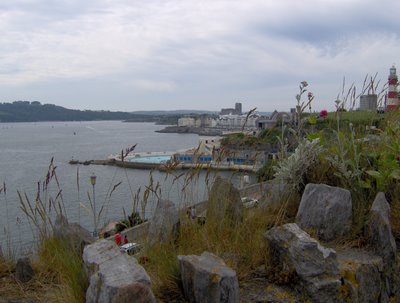 The photo above was taken on a recent day out and is of Nunney Castle. I am a member of a group called 'English Heritage' who maintain many historical sites and structures accross England and so we decided to visit this castle which is one they look after. From the picture in the brochure it looked rather substantial, having a moat and towers and so we set off on the 2 hour drive there. We had to laugh when we got there though as it was only the size of a very large house which came as a bit of a surprise! Well, we walked around it twice in opposite directions and went inside but it didn't take up much time and so we had lunch and went to Glasonbury as well, but I'll save that for another post.
The photo above was taken on a recent day out and is of Nunney Castle. I am a member of a group called 'English Heritage' who maintain many historical sites and structures accross England and so we decided to visit this castle which is one they look after. From the picture in the brochure it looked rather substantial, having a moat and towers and so we set off on the 2 hour drive there. We had to laugh when we got there though as it was only the size of a very large house which came as a bit of a surprise! Well, we walked around it twice in opposite directions and went inside but it didn't take up much time and so we had lunch and went to Glasonbury as well, but I'll save that for another post. Anyway, as you can see from the photo above it was quite an interesting little castle. Built c1373 by John DeLa Mare, Nunney Castle was designed with a strong French influence, probably obtained from its veteran owners exploits during the Hundred-Year War. Nunney Castle consists of a rectangular Tower House with large drum towers at each corner. The curtain wall between the southwest and northeast towers is so short (approx. 1m) that the towers appear to be virtually joined together.
Anyway, as you can see from the photo above it was quite an interesting little castle. Built c1373 by John DeLa Mare, Nunney Castle was designed with a strong French influence, probably obtained from its veteran owners exploits during the Hundred-Year War. Nunney Castle consists of a rectangular Tower House with large drum towers at each corner. The curtain wall between the southwest and northeast towers is so short (approx. 1m) that the towers appear to be virtually joined together.Nunney Castle is surrounded by a moat, which was restored in the early part of the 20th century. Originally this would have been far more substantial, with water extending to the castle walls. Accommodation was arranged with a kitchen on the ground floor, where remains of a large fire place and side oven are still visible, and storage facilities in the base of the towers with a well at one end. Servants quarters were on the first floor of the tower, with the Great Hall and Lord's Solar occupying the 2nd and 3rd floors respectively. The upper storeys of the towers would have provided additional accommodation, and a Chapel was located at the top of the southwest tower.

Little is known of Nunney Castle's history and it appears to have been largely uneventful. The most notable chapter seems to have been during the Civil War when it was besieged by Cromwell's troops, but capitulated within two days. Never designed to withstand cannon, the north wall was soon breached above the entrance, the hole remaining until 1910 when the bulk of the wall to collapsed. This resulted in the great void that is a prominent feature of Nunney Castle today. After the Civil War, Nunney Castle's roof was removed to render it uninhabitable, and so it has remained ever since.










